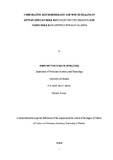| dc.description.abstract | The skin lines the body surface and therefore is in direct contact with the immediate environment that an animal inhabits. As such, it is prone to injury. Interspecific differences may exist in the content and organization of the dermis and similarly between species’ ability to heal injured skin. Furthermore, how the adnexa ( the outcome of the healing process is incompletely understood. In order to examine this question, two mammals, one bearing a thick hair coat having very sparsely distributed hairs .The initial study sought to establish the structure of the skin in the two species and to determine any differences that may reflect their unique subterranean habitats. Skin samples from different cutaneous sites were obtained from five animals of each species. The skin samples were processed for histology, electron microscopy and morphometric analysis. Morphometric analysis entailed measurement of the thickness of the overall skin, epidermis and stratum corneum. There were notable morphological differences between the skins of these two animal species. Tachyoryctes ibeanus had an insulating adipose tissue layer constituting the hypodermis in the dorsum and a dermis containing compound hair follicles associated with the arrector pili muscle. Sweat glands were only located in the pubic region.
Conversely, the skin of Heterocephalus glaber had adipose tissue consisting mainly of
unilocular adipocytes which were sparsely distributed and occurred either as isolated or grouped cells forming a discontinuous layer. The dermis of the naked mole rat contained pigment cells and very sparsely distributed simple tactile hair follicles which were well equipped with longitudinal palisades of lanceolate nerve endings and were lacking an arrector
pili muscle. Large multilobular sebaceous glands were observed in labial lobes and pubic regions in Heterocephalus glaber. In both animals, the rhinarium
palmar and plantar pads had a highly interdigitated dermal-epidermal interface which were well innervated. The average total skin thickness was significantly greater i n Tachyoryctes
ibeanus than Heterocephalus glaber’s neck, thoracic, lumbar and abdominal regions and sternal regions was significantly greater in Heterocephalus glaber than Tachyoryctes
ibeanus by mechanical, temperature, and sensory aspects of their unique subterranean environments.
To examine wound healing in these mammals, two full thickness excisional wounds on halothane anaesthetized animal, were made on the lumbal dorsum using a 4mm biopsy punch. Progression of wound repair was monitored daily, wound diameter measured and photographs taken upto day 80 post-wounding. The wounded skin was excised at day 3, 7, 14, 30 and 80 post- wounding for histological analysis. In each time-point, five animals of each species were used. Semi-quantitative parameters inflammatory cells, fibroblasts, collagen and elastic tissue histological changes during wound healing. In Tachyoryctes ibeanus, the scab was shed between days 12-14 post-wounding and wounds healed by forming a prominent scar. In contrast, Heterocephalus glaber took more time to shed the scab taking between days 21-24
after wounding with the wound showing less scarring. Fibroblast proliferation and migration, collagen and elastic fibres deposition in the wound area occurred much earlier in
Tachyoryctes ibeanus compared to Heterocephalus glaber. Furthermore, the inflammatory phase was prolonged in Heterocephalus glaber, where polyphonuclear cells were noted in the wound area, 7 days post-wounding. These observations indicate a much slower healing process in Heterocephalus glaber compared to Tachyoryctes ibeanus but with a better wound healing quality. The differences in healing between the two species could be attributed to their markedly different skin structure. Further studies need to be carried out to understand the molecular mechanisms that may be involved in the wound healing process in Heterocephalus
glaber and Tachyoryctes ibeanus. | en |

